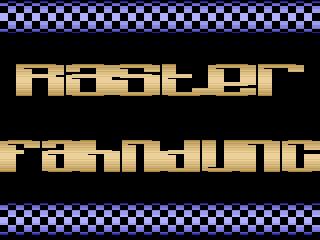
While producing the limited edition of A-VCS-tec Challenge I pondered about the next game project and thought that a game for either one or two players simultaneously would be nice. I already programmed some small demo effects - one of them being a rotating chessboard tube. The demo effects form the intro of Raster Fahndung now and the chessboard lead to the idee of searching for small patterns inside a board with a big pattern. I considered if such a game would be possible on the Atari 2600, because the limited RAM of only 128 bytes would have direct influence on the size of the pattern. When the main display routine proved to be possible all the game elements were added aswell as the one or two players option.
The game title itself is a german description of the game's objective: to search for a
specific pattern, but notmally it's used by the police. The expression "Rasterfahndung" itself
was the german "bad word of the year 1980" and may be translated to "dragnet investigation".
As 1980 was about the time of the Atari VCS being strong, I concidered this title being perfect.
The cartridge starts up with displaying the bouncing game logo and two rotating chessboard tubes.

After some seconds the cartridge displays the copyright information along with a conversion of my "Denker2000" picture which I first drew some years ago on the C64.
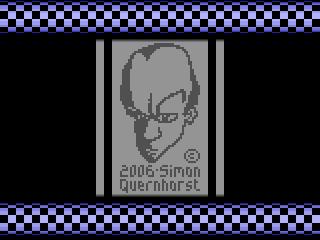
In the intro you can choose to play a one or two players game by either pressing fire of joystick one or joystick two. The one player game starts with a random board and your cursor located in the middle. Above the board is a countdown timer and the player's score is shown below the board.
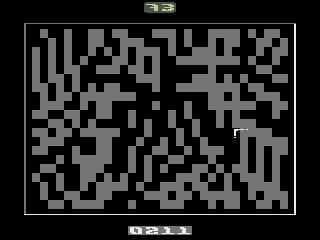
Pressing the fire button of your joystick shows the pattern which you have to find inside the board.
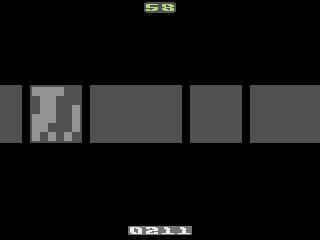
Releasing the fire button brings you back to the board where you have to search for the pattern. Pressing the fire button at the right position awards you with the remaining time as points and the next level. Pressing the button at a wrong position shows the small pattern again.
The game ends when the time counter runs to 00. To make things a bit more difficult, the
time counter runs faster when the small pattern is displayed.
If you chose the two players game in the intro, the game starts with two different cursors inside the board and individual scores for each player.
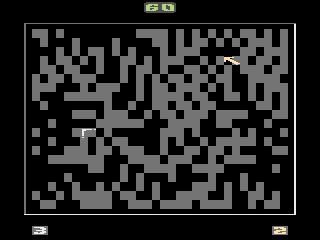
The objective is the same as in the one player game: look at the pattern and search for it inside the game board. Both players can watch the small pattern individually, but remember that the time runs faster when the small pattern is shown.
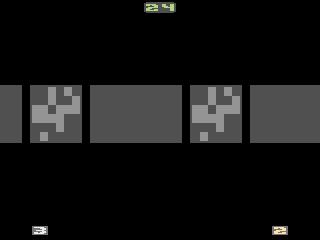
Releasing the fire button brings you back to the board where you have to search for the pattern. Pressing the fire button at the right position awards the winning player with one point and the game continues with the next level. Pressing the button on a wrong position shows the small pattern again.
The game ends when either the time counter runs to 00 or one of the players manages to reach 9
points. To make things a bit more difficult, the time counter runs faster when the small pattern is displayed. It runs even faster if both players press the fire button at the same time.
The game is written in 6507 assembly and consists of 4 KB (4096 Bytes) of coding, graphics and sound effects. The VCS only offers 128 bytes of RAM of which 80 Bytes are used for the random playfield alone. The remaining space is needed for the position coordinates of the players, the scores, the timer, the small pattern and some technical information. Creating the excerpt of the small pattern from the random playfield uses a lot of bit shifting due to the complex way the Atari handles its display - every second value is stored with the bits in reversed order for example.
Due to differences between PAL- and NTSC-consoles, the game needs to be adjusted to both TV-standards. The first development version was PAL format (312 scanlines, 50 Hz) and converted to NTSC (262 scanlines, 60 Hz) afterwards.
The development was performed on a Pentium-PC
using a normal Text-Pad as editor and DASM V2.12 as compiler.
Testing was done using the emulator z26 V1.52 and V1.58.
The game is released as a limited edition of 75 copies first. The limited edition contains these items: PAL/NTSC-cartridge, plastic box, instruction manual, photo print, serialnumber and signature. Every limited edition cartridge contains a switch on the back of the cartridge to choose PAL or NTSC mode.
Besides the limited edition of 75 copies, the unlimited run (normal cartridge and manual only) will supply as many copies as requested. Please order your copy of the unlimited edition game cartridge (PAL or NTSC) with manual directly from this retailer:

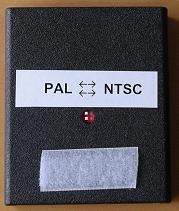
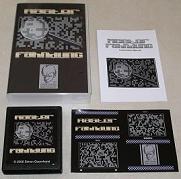
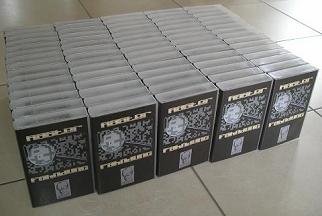
| # | Name | Country |
| 01 | Simon Quernhorst | Germany |
| 02 | Christian Keller | Germany |
| 03 | Marc Oberhäuser | Germany |
| 04 | Jeff Rothkopf | USA |
| 05 | Remowilliams | USA |
| 06 | Rick Weis | USA |
| 07 | Jose Garcia | USA |
| 08 | Kai Darius Kohl | USA |
| 09 | Carl Howard | USA |
| 10 | r_type2600 | Austria |
| 11 | Christoph Pistner | Germany |
| 12 | Mat Allen | England |
| 13 | Walter Lauer | Germany |
| 14 | Richard Lecce | USA |
| 15 | Mike Chassin | USA |
| 16 | Luke Sandel | USA |
| 17 | Michael Weiß | Germany |
| 18 | Cyril Denis | France |
| 19 | Jörg Lennhof | Germany |
| 20 | Dieter Kosancic | Germany |
| 21 | Jose Artiles | USA |
| 22 | Michael Garber | USA |
| 23 | Al Backiel | USA |
| 24 | Leonard Hermann | USA |
| 25 | Fabian Grossekemper | Switzerland |
| 26 | Philip Rubin | USA |
| 27 | Ingo Boyens | Germany |
| 28 | Michael Tausendpfund | Germany |
| 29 | Gregor Houghton | England |
| 30 | Matthias David | Germany |
| 31 | Ed Mann | USA |
| 32 | Ryan Hefferan | Australia |
| 33 | Andy Ryals | England |
| 34 | Dan Cremins | USA |
| 35 | Rob Neitzke | USA |
| 36 | Jerry Greiner | USA |
| 37 | Syd Bolton | Canada |
| 38 | Lance Bohy | USA |
| 39 | Chris Austin | USA |
| 40 | René Meyer | Germany |
| 41 | Horst Lienert | Germany |
| 42 | Jörg Konzan | Germany |
| 43 | Lori Burgener | USA |
| 44 | Marco Kerstens | The Netherlands |
| 45 | Alain Kohn | Luxemburg |
| 46 | Hartmut Ahl | Germany |
| 47 | Yannis Pachnis | England |
| 48 | Mr. Atari | The Netherlands |
| 49 | SOLD | Germany |
| 50 | Jim Donahue | USA |
| 51 | Lars Willemsen | Germany |
| 52 | Lukas Meller | Germany |
| 53 | Dan Cage | USA |
| 54 | Gilles Bordelais | Belgium |
| 55 | Jörg Müller | Germany |
| 56 | Computerspielemuseum Berlin | Germany |
| 57 | Ron Engel | USA |
| 58 | Christian Gleinser | Germany |
| 59 | Michael Braun | Germany |
| 60 | Conny Jungholt | Germany |
| 61 | Binarium | Germany |
| 62 | Sascha Hensel | Germany |
| 63 | Bernd Neikes | Germany |
| 64 | Arne Israel | Germany |
| 65 | AntaBaka | Germany |
| 66 | SOLD | Germany |
| 67 | Florian | Germany |
| 68 | Russ Perry jr. | USA |
| 69 | Holger Meller | Germany |
| 70 | Oliver Schlesier | Germany |
| 71 | Ralf Griewel | Germany |
| 72 | Kevin Roeper | Germany |
| 73 | Boris Kretzinger | Germany |
| 74 | Jörg Dröge | Germany |
| 75 | Tim Benish | USA |